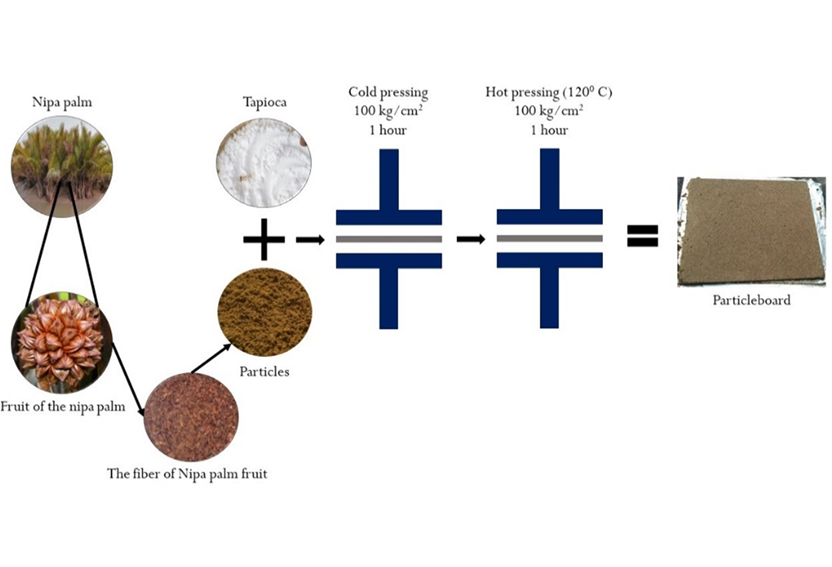The investigation of physical dan mechanical properties of Nipah-based particle board
Abstract
The excessive use of wood as a raw material in furniture industries has raised environmental concerns that have attracted the attention of many individuals. Consequently, various innovations have been explored in developing alternative materials for the furniture industry. One promising resource that has the potential to be developed as a raw material for furniture applications is Nipah palm husk. Nipah palm husk is classified as an agricultural waste that is barely used within society and industries. Hence, in this study, Nipah palm husk will be utilized as the primary material to fabricate particle board by involving tapioca as an adhesive. This research aimed to investigate the effect of tapioca concentrations on water absorption, modulus elasticity, modulus of rupture, and screw-holding strength of the produced Nipah palm husk particleboard. The results of this study showed that the particle board produced with a 40% tapioca adhesive concentration exhibited the most favorable physical and mechanical properties with a water absorption rate of 25%, an elastic modulus of 21188.93 kg/cm2, a modulus of rupture of 55.53 kg/cm2, and a screw holding power of 7.53 kg. The findings indicated that Nipah-based particle board has the potential to be developed as an alternative for the furniture industry.
References
T. M. Maloney, Modern particleboard & dry-process fiberboard manufacturing. San Francisco: Miller Freeman, 1993.
D. D. Karyaparambil, S. Erland, P. van Hees, V. Frette, and B. C. Hagen, “Flame heights and charring on a particle board – An experimental study,” Fire Saf J, vol. 134, p. 103675, Dec. 2022, https://doi.org/10.1016/j.firesaf.2022.103675
M. Pędzik, D. Janiszewska, and T. Rogoziński, “Alternative lignocellulosic raw materials in particleboard production: A review,” Ind Crops Prod, vol. 174, p. 114162, Dec. 2021, https://doi.org/10.1016/j.indcrop.2021.114162
S. O. Odeyemi, R. Abdulwahab, A. G. Adeniyi, and O. D. Atoyebi, “Physical and mechanical properties of cement-bonded particle board produced from African balsam tree (Populous Balsamifera) and periwinkle shell residues,” Results in Engineering, vol. 6, p. 100126, Jun. 2020, https://doi.org/10.1016/j.rineng.2020.100126
V. Lazić, D. Arsić, M. Mutavdžić, R. R. Nikolić, and B. Hadzima, “Analysis of certain physical properties of four rock materials,” Applied Engineering Letters, vol. 5, no. 4, pp. 111–119, 2020, https://doi.org/10.18485/aeletters.2020.5.4.1
M. R. Sanjay, G. R. Arpitha, L. L. Naik, K. Gopalakrishna, and B. Yogesha, “Applications of Natural Fibers and Its Composites: An Overview,” Natural Resources, vol. 07, no. 03, pp. 108–114, 2016, https://doi.org/10.4236/nr.2016.73011
A. Larregle et al., “Antifungal Soybean Protein Concentrate Adhesive as Binder of Rice Husk Particleboards,” Polymers (Basel), vol. 13, no. 20, p. 3540, Oct. 2021, https://doi.org/10.3390/polym13203540
R. M. Alviana, M. S. Anwar, and E. S. Siradj, “Evaluation of Microstructure High Chrome Austenitic Stainless-Steel grade 253MA after Creep Test at Temperature of 700°C,” Jurnal Pendidikan Teknologi Kejuruan, vol. 6, no. 1, pp. 41–47, Mar. 2023, https://doi.org/10.24036/jptk.v6i1.31523
B. R. Roszardi, R. Riastuti, W. Budiarto, N. Darsono, and A. N. Syahid, “Corrosion Behavior of Super Austenitic Stainless Steel, Duplex 2205 and 316L in Sulfamic Acid Environment,” Jurnal Pendidikan Teknologi Kejuruan, vol. 4, no. 4, pp. 146–151, Dec. 2021, https://doi.org/10.24036/jptk.v4i4.24323
M. P. Todor, C. Bulei, and I. Kiss, “Inducing the biodegradability of polymeric composite materials using bioranforts,” Applied Engineering Letters, vol. 2, no. 2, pp. 84–90, 2017.
M. A. Batiancela, M. N. Acda, and R. J. Cabangon, “Particleboard from waste tea leaves and wood particles,” J Compos Mater, vol. 48, no. 8, pp. 911–916, Apr. 2014, https://doi.org/10.1177/0021998313480196
H. Younesi-Kordkheili and A. Pizzi, “A Comparison among Lignin Modification Methods on the Properties of Lignin–Phenol–Formaldehyde Resin as Wood Adhesive,” Polymers (Basel), vol. 13, no. 20, p. 3502, Oct. 2021, https://doi.org/10.3390/polym13203502
M. Arsyad, M. Z. Umar, and M. Umar, “Physical Test of Energy Saving Composite Board from Nipah Leaves nypa fruticans,” in Proceeding of Marine Safety and Maritime Installation (MSMI 2018), Clausius Scientific Press, 2018. https://doi.org/10.23977/msmi.2018.82611
R. Tampubolon, E. Sribudiani, S. Somadona, Y. Amin, and S. S. Kusumah, “Characteristics of Particleboard from Sorghum and Nypa Fruit Skin Fiber Bonded with Citric Acid-Sucrose Adhesive,” Jurnal Sylva Lestari, vol. 10, no. 3, pp. 426–438, Sep. 2022, https://doi.org/10.23960/jsl.v10i3.574
M. Saddikin, H. Nurdin, and P. Primawati, “Analysis Physical and Mechanical Of Particle Boards Raw Materials Nipah Fruit Fiber,” Teknomekanik, vol. 2, no. 1, pp. 14–19, Jun. 2019, https://doi.org/10.24036/tm.v2i1.2672
H. Nurdin, Hasanuddin, Waskito, and M. Saddikin, “Characteristics of Particleboard From Waste Nypa Fruticans Wurmb,” J Phys Conf Ser, vol. 1387, no. 1, p. 012103, Nov. 2019, https://doi.org/10.1088/1742-6596/1387/1/012103
P. Boruszewski, P. Borysiuk, A. Jankowska, and J. Pazik, “Low-Density Particleboards Modified with Expanded and Unexpanded Fillers—Characteristics and Properties,” Materials, vol. 15, no. 13, p. 4430, Jun. 2022, https://doi.org/10.3390/ma15134430
M. Badila et al., “Powder coating of veneered particle board surfaces by hot pressing,” Prog Org Coat, vol. 77, no. 10, pp. 1547–1553, Oct. 2014, https://doi.org/10.1016/j.porgcoat.2013.09.018
R. Zakaria et al., “Properties of Particleboard from Oil Palm Biomasses Bonded with Citric Acid and Tapioca Starch,” Polymers (Basel), vol. 13, no. 20, p. 3494, Oct. 2021, https://doi.org/10.3390/polym13203494
E. Dewi, S. Chodijah, and M. Elina, “The Characteristics of Particle Board from Empty Fruit Palm Oil (elaeis guineensis jacq) using an Adhesive of Liquid Guava Rod Bark,” J Phys Conf Ser, vol. 1167, p. 012058, Feb. 2019, https://doi.org/10.1088/1742-6596/1167/1/012058
A. F. Nongman, A. Baharin, and A. A. Bakar, “The Effect of Banana Leaves Lamination on the Mechanical Properties of Particle Board Panel,” Procedia Chem, vol. 19, pp. 943–948, 2016, https://doi.org/10.1016/j.proche.2016.03.139

Copyright (c) 2023 Hendri Nurdin, Waskito Waskito, Anna Niska Fauza, Batu Mahadi Siregar, Bagdaulet Kenzhaliyevich Kenzhaliyev (Author)

This work is licensed under a Creative Commons Attribution 4.0 International License.






